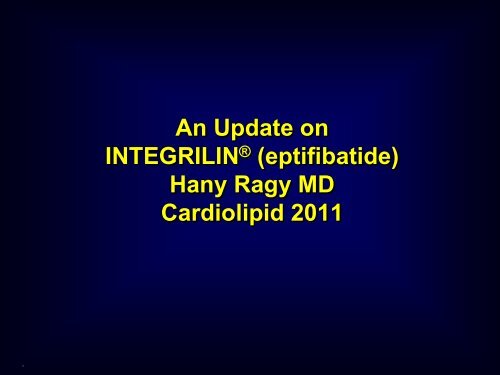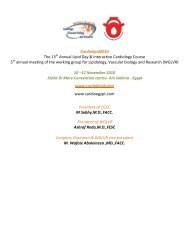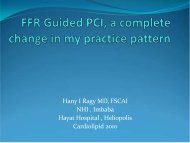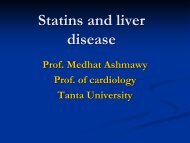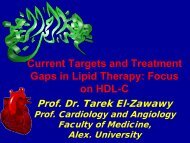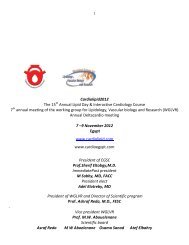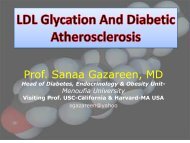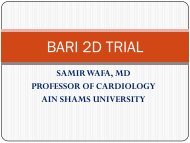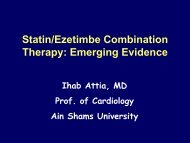INTEGRILIN® (eptifibatide) Injection Clinical Support Slide Lecture ...
INTEGRILIN® (eptifibatide) Injection Clinical Support Slide Lecture ...
INTEGRILIN® (eptifibatide) Injection Clinical Support Slide Lecture ...
- No tags were found...
You also want an ePaper? Increase the reach of your titles
YUMPU automatically turns print PDFs into web optimized ePapers that Google loves.
.An Update onINTEGRILIN ® (<strong>eptifibatide</strong>)Hany Ragy MDCardiolipid 2011
The Role of Platelets inAtherothrombosis1 Adhesion 3 Aggregation2Activation<strong>Slide</strong> modified from Cannon CP, et al. Available at http://www.theheart.org/viewArticle.do?primaryKey=119759.Accessed April 20, 2005.
Thrombus and Microemboli:The heart of the matterCourtesy C.M. Gibson
Antiplatelet and Anticoagulant Agentsin the Setting of NSTE ACSAspirin,thienopyridines,and anticoagulantseachblock a singlepathway(thromboxane A2,ADP, and thrombin,respectively) toinhibit plateletactivation.Therapeutic Goal: inhibit plateletaggregation to prevent distal embolizationwith microvascular occlusionGP IIb-IIIainhibitors preventplatelet aggregationand improveperfusion to themicrovasculature.Aspirin blocksinflammatory activitiesthat could furtherdestabilize plaque.White HD. Am J Cardiol. 1997;80(4A):2B-10B; DeJong MJ, et al. Crit Care Nurs Clin North Am.1999;11(3):355-371.
MI Ratepursuit6%4%Early Use of EptifibatidePre-PCI* in ACS67.2% (P = 0.001)Aspirin + heparin5.5%(n = 631)2%Aspirin + heparin + <strong>eptifibatide</strong> 180/2 †1.8%(n = 619)01 2 3Days from EnrollmentPost-randomization analysis in a subset of patients prior to undergoing early PCI; all patients were to receive aspirinand heparin therapy.*PCI = percutaneous coronary intervention; † 180/2 = 180-mcg/kg bolus followed by a 2-mcg/kg/min infusion.Fintel DJ, et al. Clin Cardiol. 2000;23(Suppl V):V1-V12; Data on file, Millennium Pharmaceuticals, Inc.
PURSUIT: Death or MI With/WithoutEarly PCI%Placebo Eptifibatide96 HoursEarly PCI 15.3 9.2No early PCI 7.7 5.57 DaysEarly PCI 16.0 9.9No early PCI 10.8 8.830 DaysEarly PCI 16.7 11.2No early PCI 15.0 12.26 MonthsEarly PCI 19.8 15.1No early PCI 18.6 15.3Death or myocardial reinfarctionFavors <strong>eptifibatide</strong>Favors placeboEarly PCI: n = 450No early PCI: n = 13160.5 1 2OR (95% CI)Lincoff AM et al. Circulation 2000;102:1093-100.
pursuitMI Prior to PCI% Mortality at 6 Months15%10%15.2%77.0% in mortality(P = 0.0001)5%3.5%0MI Prior to PCI(n = 46)Post-randomization analysis in a subset of patients in PURSUIT not intended to evaluate treatment effect.Follow-up data were available for >96% of patients through 165 days.*PCI = percutaneous coronary intervention.Fintel DJ, et al. Clin Cardiol. 2000;23(Suppl V):V1-V12; Data on file, Schering-PloughNo MI Prior to PCI(n = 1204)
ESPRIT: Study DesignEnhanced Suppression of the Platelet IIb/IIIa Receptor with Integrilin TherapyAssess effect of novel, double-bolus dose <strong>eptifibatide</strong> in coronary stentingN = 2064 undergoing stent implantationRandomized, controlled studyEptifibatide180-µg/kg double-bolus 10 min apart+ continuous infusion 2.0 µg/kg per min for 18–24 hPlaceboAspirin + heparin + thienopyridinePrimary outcome:Death, MI, urgent revascularizationand thrombotic bailout after GP IIb/IIIa inhibitor ≤48 hSecondary outcome:Death/MI/urgent revascularization at 30 daysESPRIT Investigators. Lancet. 2000;356:2037-44.
Baseline Inhibition (%)Inhibition of Platelet Aggregation withEptifibatide 180 / 2.0 / 180(Light Transmission Aggregometry with 20 µM ADP & PPACK)1008092.4Platelet Aggregation Inhibition95.198.795.399.5MinimumTarget604020015 min 30 min 60 min 120 min 360 minTime from Initiation of DosingChoo J et al. J Am Coll Cardiol. 2000;86(Suppl 8A):71i.
ESPRIT: Primary Outcome Over Time25Death/MI/TVR/thrombotic bailout within 48 hoursRR = 0.76(95% Cl 0.63–0.93)P = 0.0068Primaryendpoint(%)201510RR = 0.65(95% Cl 0.47–0.87)P = 0.0045RR = 0.65(95% Cl 0.49–0.87)P = 0.003450TVR = target vessel revascularization48 hours 30 days 12 monthsPlaceboEptifibatideGranada JF, Kleiman NS. Am J Cardiovasc Drugs.2004:4:31-41.
Death or MI* at 30 Days With Eptifibatide Withor Without Clopidogrel Pretreatment Loading15%10%11.7%CI=0.58 (0.38-0.87) n=1016CI=0.63 (0.37-1.06) n=9015%8.4%7.1%5.4%0Aspirin + heparin Aspirin + heparin +clopidogrelEptifibatide†180/2/180 + aspirin+ heparinEptifibatide180/2/180 + aspirin+ heparin +clopidogrel*MI = myocardial infarction; † 180/2/180 = 180-mcg/kg bolus followed by a 2-mcg/kg/min infusion, with a second 180-mcg/kg bolus 10minutes after the first bolus.Post-randomization analysis of a subset of patients in ESPRIT. Follow-up data were available for 95.2% of all patients out to 12months.These results are based on subgroup analyses, conducted post-randomization, in selected populations not powered to evaluatetreatment effect.Dery et al, Catheterization and Cardiovascular Interventions, in press.
Cumulative Event Rate1-Year Death and MI20%36.6% mean (P = 0.001)15%10.2%11.5%12.4%10%6.3%7.4%8.0%5%PlaceboEptifibatide 180/2/180*02 4 6 8 10 12Months After Enrollment*180/2/180 = 180-mcg/kg bolus followed by a 2-mcg/kg/min infusion, with a second 180-mcg/kg bolus10 minutes after the first bolus.O’Shea JC, et al. JAMA. 2002;287(5):618-621.
Death, MI, UTVR, or TBO at30 Days by Diagnosis49.7%(P = 0.03)40.7%(P = 0.03)(P = ns)20%17.1%15%12.3%10%8.6%7.9%8.0%6.1%5%0ACS < 48 hours ACS ≥ 48 hours Stable angina(n = 279) (n = 664) (n = 794)Data on file. Millennium Pharmaceuticals, Inc.Aspirin + heparin +/- clopidogrelEptifibatide 180/2/180* + aspirin + heparin+/- clopidogrel
EVA-AMI: Eptifibatide Equal to Abciximab forSTEMI Patients Undergoing PCIEVA-AMI randomized 400 STEMI patients with less than 12 hours ofsymptoms to either a double bolus plus 24-hour infusion ofEptifibatide or a single bolus plus 12-hour infusion of Abciximab• The primary end point: ST resolution one hour post-PCI.In fact, the proportion of patients with no ST resolutionafter 60 minutes was statistically lower in the Eptifibatidearm (14.7% vs. 5.4%, p=0.021).• In-hospital events, including death, reinfarction, heartfailure, target vessel revascularization (TVR), and CABG,were similar between the two groups
EVA-AMI: Eptifibatide Equal to Abciximab forSTEMI Patients Undergoing PCI• Major and minor bleeding rates were also nonsignificantly different between the two GP-IIb/IIIa-inhibitorstrategies .• EVA-AMI study is the first to show that a small-moleculeGP IIb/IIIa inhibitor is as effective as abciximab in thesetting of PCI for STEMI. "Since this drug is lessexpensive, it might be more useful in clinical practice andthe guidelines might be changed .
The FATA trial (Facilitated Angioplastywith Tirofiban or Abciximab)• was a prospective, multicentre, open-label trial thatenrolled 692 patients with ST-segment elevationmyocardial infarction (STEMI) undergoing PPCI• Patients were randomized 1:1 to receive abciximab (n =341) or HDB tirofiban (n = 351).• Primary endpoint was the rate of complete ( 70%) STR90 min after first balloon inflation.• Thirty-day incidence of major bleedings, death, reinfarctionand new revascularizations was alsoevaluated.
The FATA trial ( Facilitated Angioplastywith Tirofiban or Abciximab)• Baseline characteristics of the two groups were well-balanced, withthe exception of previous MI rates ( Tirofiban 6% vs. Abciximab2.6%, P = 0.03). The procedure was successful in 96.7% of theAbciximab and in 96.6% of the Tirofiban cohort (P = 0.94).• Complete STR was obtained in 67.05% of the Tirofiban and 70.45%of the Abciximab group ( –3.4%, 95% confidence interval –10.35 to+3.56).• Falls beyond the predefined ± 10% equivalence boundaries. Ratesof secondary endpoints were similar between the two groups.• Conclusion: This study failed to show the equivalence of HBD ofTirofiban and Abciximab as adjunctive therapy to PPCI.
Eptifibatide vs. Bivalirudin for PCI inUA/NSTEMINo clear winner emerged from the PROTECT-TIMI-30 randomized trial.• In this small, randomized study of high-riskpatients undergoing PCI, coronary flowreserve improved more and minorbleeding was less common with bivalirudinthan with <strong>eptifibatide</strong>. However, myocardialperfusion improved more and ischemialasted less time with <strong>eptifibatide</strong>.• PROTECT-TIMI-30 trial. J Am Coll Cardiol 2006 Jun 20;47:2364-73.
Figure 1. Percent inhibition of platelet aggregation (IPA) drawn from the femoral vein at 15, 30,and 60 minutes after bolus administration of <strong>eptifibatide</strong> with 20 μmol/L ADP as the plateletagonist.Deibele A J et al. Circulation 2010;121:784-791Copyright © American Heart Association
Figure 2. Percent inhibition of platelet aggregation (IPA) drawn from the femoral vein at 15, 30,and 60 minutes after bolus administration of <strong>eptifibatide</strong> with 5 μmol/L thrombin receptoragonist peptide as the platelet agonist.Deibele A J et al. Circulation 2010;121:784-791Copyright © American Heart Association
Figure 3. Percent platelet GP IIb/IIIa RO during the bolus <strong>eptifibatide</strong> administration isdemonstrated for the femoral vein and coronary sinus comparing the intravenous andintracoronary groups for bolus 1 and bolus 2.Deibele A J et al. Circulation 2010;121:784-791Copyright © American Heart Association
Figure 4. Percent platelet GP IIb/IIIa RO during the bolus <strong>eptifibatide</strong> administration isdemonstrated for the femoral vein and coronary sinus within the intracoronary andintravenous groups for bolus 1 and bolus 2.Deibele A J et al. Circulation 2010;121:784-791Copyright © American Heart Association
Figure 5. The pre-PCI cTFC and post-PCI cTFC were not linearly distributed.Deibele A J et al. Circulation 2010;121:784-791Copyright © American Heart Association
Figure 6. The post-PCI TMPG.Deibele A J et al. Circulation 2010;121:784-791Copyright © American Heart Association
A Well-Established Safety Profile
pursuitMajor and Minor TIMI Bleeding DuringHospitalization by ProcedureProcedureAspirin +/-heparin(n = 4577)Major Bleeding*Eptifibatide180/2 + aspirin+/- heparin(n = 4604)Minor Bleeding*Aspirin +/-heparin(n = 4577)Eptifibatide180/2 + aspirin+/- heparin(n = 4604)Overall 9.3% 10.8% 7.6% 13.1%Patients with CABG † 8.2% 8.2% 3.4% 3.4%Patients with PCI(excluding CABG)Patients withangiography(excluding CABG or PCI)0.6% 1.4% 2.2% 4.3%0.2% 0.6% 0.8% 2.2%Patients with no cardiacprocedures0.3% 0.6% 1.1% 3.2%*Major bleeding (TIMI criteria) = a bleeding event resulting in a drop in hemoglobin (Hgb) of > 5 g/dL; minor bleeding(TIMI criteria) = a bleeding event resulting in a drop in Hgb of > 3 g/dL; † CABG = coronary artery bypass graft.INTEGRILIN ® (<strong>eptifibatide</strong>) <strong>Injection</strong> Prescribing Information. Schering Corporation.Data on file. Schering Corporation. 6/06
Major and Minor TIMI Bleeding DuringHospitalizationAspirin +heparin + clopidogrel(n = 1024)Eptifibatide180/2/180* + aspirin+ heparin + clopidogrel(n = 1040)TIMI major † 0.4% 1.3%TIMI minor † 2.0% 3.0%*180/2/180 = 180-mcg/kg bolus followed by a 2-mcg/kg/min infusion, with a second 180-mcg/kg bolus 10 minutes after thefirst bolus.†Major bleeding (TIMI criteria) = a bleeding event resulting in a drop in hemoglobin (Hgb) of > 5 g/dL;minor bleeding (TIMI criteria) = a bleeding event resulting in a drop in Hgb of > 3 g/dL.INTEGRILIN ® (<strong>eptifibatide</strong>) <strong>Injection</strong> Prescribing Information.ESPRIT Investigators. Lancet. 2000;356(9247):2037-2044.
Data on file at: Duke <strong>Clinical</strong> Research Institute. Jan 2001–Dec 2004.Creatinine Clearance vs Age8070Mediancreatinineclearance(ml/min)605040302010084Age (years)
<strong>Clinical</strong> Implications• Early use of antithrombotic agents plays a key role in managementof NSTE ACS, but dosing errors are common• Dosing errors occur more often in elderly and others already vulnerableto bleeding• Dosing errors predict an increased risk of major bleeding• Altering dosing based on weight and renal function minimizes bleedingwhile preserving therapeutic benefit• Patients receiving recommended doses of heparin and GP IIb-IIIainhibitors alone or in combination may have lower rates of bleedingProper dosing of antithrombotic therapies is necessaryto prevent bleeding complications in vulnerable patientsAlexander KP et al. JAMA. 2005:294:3108-3116.
INTEGRILIN ® (<strong>eptifibatide</strong>) <strong>Injection</strong>:Dosing and AdministrationCopyright 2007, Schering Corporation.
INTEGRILIN ® (<strong>eptifibatide</strong>) <strong>Injection</strong>:Indications• For the treatment of patients with acute coronarysyndrome (UA/NSTEMI), including patients who areto be managed medically and those undergoingpercutaneous coronary intervention (PCI). In thissetting INTEGRILIN ® has been shown to decreasethe rate of a combined endpoint of death or new MI.• For the treatment of patients undergoing PCI,including intracoronary stenting. In this settingINTEGRILIN ® has been shown to decrease the rateof a combined endpoint of death, new MI, or need forurgent intervention.INTEGRILIN ® (<strong>eptifibatide</strong>) <strong>Injection</strong> Prescribing Information. 6/06 Schering Corporation.
INTEGRILIN ® (<strong>eptifibatide</strong>) <strong>Injection</strong>:Contraindications• A history of bleeding diathesis, or evidence of activeabnormal bleeding within the previous 30 days• Severe hypertension (systolic blood pressure> 200 mm Hg or diastolic blood pressure > 110 mm Hg)not adequately controlled on antihypertensive therapy• Major surgery within the preceding 6 weeks• History of stroke within the preceding 30 days or anyhistory of hemorrhagic stroke• Current or planned administration of another parenteralGP IIb-IIIa inhibitor• Dependency on renal dialysis• Known hypersensitivity to any component of the productINTEGRILIN ® (<strong>eptifibatide</strong>) <strong>Injection</strong> Prescribing Information. 6/06 Schering Corporation.
INTEGRILIN ® (<strong>eptifibatide</strong>) <strong>Injection</strong>:Precautions and Warnings• Bleeding is the most common complication encounteredduring INTEGRILIN ® therapy.• The majority of excess major bleeding events werelocalized at the femoral artery access site.Oropharyngeal, genitourinary, gastrointestinal, andretroperitoneal bleeding were also seen more commonlywith INTEGRILIN ® compared to placebo.INTEGRILIN ® (<strong>eptifibatide</strong>) <strong>Injection</strong> Prescribing Information. 6/06 Schering Corporation.
INTEGRILIN ® (<strong>eptifibatide</strong>) <strong>Injection</strong>:Precautions and Warnings (continued)• In patients undergoing PCI, INTEGRILIN ® is associated withan increase in major and minor bleeding at the site of arterialsheath placement. Special care should be employed tominimize the risk of bleeding among these patients.• If bleeding cannot be controlled with pressure, infusion ofINTEGRILIN ® and concomitant heparin should be stoppedimmediately.• Because INTEGRILIN ® inhibits platelet aggregation, cautionshould be employed when it is used with drugs that affecthemostasis, including thrombolytics, oral anticoagulants,NSAIDs, and dipyridamole.• Use with other parenteral GP IIb-IIIa inhibitors should beavoided.INTEGRILIN ® (<strong>eptifibatide</strong>) <strong>Injection</strong> Prescribing Information. 6/06 Schering Corporation.
INTEGRILIN ® (<strong>eptifibatide</strong>) <strong>Injection</strong>:Precautions and Warnings (continued)• INTEGRILIN ® is cleared in part by the kidney, and itsplasma concentrations are doubled in patients with renaldisease (creatinine clearance < 50 mL/min). Therefore theinfusion dose of INTEGRILIN ® needs to be reduced to 1mcg/kg/min in these patients. INTEGRILIN ® iscontraindicated in patients who are dependent upon renaldialysis.• Caution should be exercised when administeringINTEGRILIN ® to patients with a platelet count< 100,000/mm 3 .INTEGRILIN ® (<strong>eptifibatide</strong>) <strong>Injection</strong> Prescribing Information. 6/06 Schering Corporation.
INTEGRILIN ® (<strong>eptifibatide</strong>) <strong>Injection</strong>:Properties• Specific for platelet receptor GP IIb-IIIa• Potent inhibitor of platelet aggregation• Onset of platelet aggregation inhibition within15 minutes• Reversible — restoration of platelet function toward baseline(< 50% inhibition) within 4 hours of discontinuation ofinfusion• Eptifibatide and its metabolites primarily renally excreted• Plasma elimination half-life of approximately 2.5 hoursINTEGRILIN ® (<strong>eptifibatide</strong>) <strong>Injection</strong> Prescribing Information. 6/06 Schering Corporation.Scarborough RM, et al. Circulation. 1999;100:000-000.Tcheng JE, et al. Am J Cardiol. 2001;88:1097-1002.
Dosing Label Change forPatients with Renal ImpairmentDose adjustment based solely on serumcreatinine is no longer recommended• Previous label recommended a reduced infusion of INTEGRILIN ®(<strong>eptifibatide</strong>) <strong>Injection</strong> in patients with creatinine clearance (CrCl)< 50 mL/min or serum creatinine > 2 mg/dL (if CrCl was notavailable) from 2 mcg/kg/min to 1 mcg/kg/min• Current label (Rev. 11) recommends a reduced infusion dose ofINTEGRILIN ® in patients with CrCl < 50 mL/min from2 mcg/kg/min to 1 mcg/kg/minINTEGRILIN ® (<strong>eptifibatide</strong>) <strong>Injection</strong> Prescribing Information. 06/06. Schering Corporation.
INTEGRILIN ® (<strong>eptifibatide</strong>) <strong>Injection</strong>: DosingGuidelines for UA/NSTEMI and PCI PatientsINTEGRILIN ®Calculated creatinine clearance ≥ 50 mL/min• 180-mcg/kg bolus• 2-mcg/kg/min continuous infusion until:– Initiation of CABG surgery– 18-24 hours post-PCI– A minimum of 12 hours infusion isrecommended– Hospital discharge, up to 72 hours• A second 180-mcg/kg bolus should beadministered 10 minutes after the firstwhen INTEGRILIN ® is initiated at thetime of PCICalculated creatinine clearance < 50 mL/min• 180-mcg/kg bolus• 1-mcg/kg/min continuous infusion until:– Initiation of CABG surgery– 18-24 hours post-PCI– A minimum of 12 hours infusion isrecommended– Hospital discharge, up to 72 hours• A second 180-mcg/kg bolus should beadministered 10 minutes after the firstwhen INTEGRILIN ® is initiated at thetime of PCIAt the time of PCI:Aspirin• 160 to 325 mg orally 1 – 24 hours prior to PCI, daily thereafter• Target ACT 200 – 300 seconds during PCIHeparin• Additional boluses during PCI to maintain ACT within target• Heparin infusion after PCI is strongly discouraged* INTEGRILIN ® is contraindicated in patients with dependency on renal dialysisINTEGRILIN® (<strong>eptifibatide</strong>) <strong>Injection</strong> Prescribing Information. 06/06. Schering Corporation.
INTEGRILIN TM (<strong>eptifibatide</strong>) <strong>Injection</strong>:Ease of Use No reconstitution No dilution No preparation time required No refrigeration required (may bestored at room temperature 25 o Cfor up to 2 months)INTEGRILIN TM (<strong>eptifibatide</strong>) <strong>Injection</strong> Prescribing Information. 06/06. Schering Corporation.
INTEGRILIN ® (<strong>eptifibatide</strong>) <strong>Injection</strong>:Bolus Delivery• Withdraw weight-adjustedbolus dose (determinedfrom dosing chart inPrescribing Information)from a 10-mL bolus vial intoa syringe.• Deliver via IV push into IVport closest to the patient.INTEGRILIN ® (<strong>eptifibatide</strong>) <strong>Injection</strong> Prescribing Information. 06/06. Schering Corporation.
INTEGRILIN ® (<strong>eptifibatide</strong>) <strong>Injection</strong>:Infusion Delivery• Spike the 100-mL infusionvial with a vented IVinfusion set. Care shouldbe taken to center the spikewithin the circle on thestopper top.• Hang infusion vial from IVpole via the self-containedhanging mechanism.• Administer directly intoindwelling IV port or viainfusion port of maintenanceintravenous solution.INTEGRILIN ® (<strong>eptifibatide</strong>) <strong>Injection</strong> Prescribing Information. 06/06. Schering Corporation.
2011 ACC/AHA focused Update of the 2007 Guidelines for UA/NSTEMIManagement of UA/NSTEMI patients undergoing an Initial InvasiveStrategyAspirin (IA)Clopidogrel if Aspirin intolerant (IB)Invasive StrategyInitiate anticoagulant therapy (IA)Acceptable options: Enoxaparin or UFH (IA)/ Fondaparinux or Bivalirudin (IB)Prior to angiographyAdd second antiplatelet agent (IA):GP IIb/IIIa inhibitor (IA)Clopidogrel (IB)CABGMaintain ASA (IA)Wright et al. JACC Vol. 57, No. 18, 2011PCIClopidogrel (if not startedprecathetarization) (IA)Prasugrel (IB)GP IIb/IIIa inhibitor if not startedprecathetarization) (IA)Discharge RxDiscontinue IIb/IIIainhibitors and giveclo[idogrel perconsevative strategy
SUMMARY of 2011 ACC/AHA focused Update of the 2007Guidelines for UA/NSTEMIClass I: Benefits >>>> Risk (Should be given)‣ If initial INVASIVE strategy is selected then dual-antiplatelet therapy isrecommended on presentation• Before PCI:• ASA + Clopidogrel (Level B)• ASA + An IV GP IIb/IIIa inhibitor (Level A)• At the time of PCI• ASA + Clopidogrel (if not started) (Level A)• ASA + Prasugrel (Level B)• ASA + An IV GP IIb/IIIa inhibitor (Level A)‣ If initial CONSERVATIVE strategy is selected and diagnostic angiography isrecommended• Upstream Clopidogrel + ASA + anticoagulant therapy (Level B)• Upstream IV GP IIb/IIIa inhibitor + ASA + anticagulant therapy (Level A)
SUMMARY of 2011 ACC/AHA focused Update of the 2007Guidelines for UA/NSTEMIClass IIa: Benefit > Risk (Reasonable to give)‣ If PCI has been selected as a post-angiography management strategy• Administer an IV GP IIb/IIIa inhibitor, if not started before the diagnostic angiography(particularly for trponin-positive and/or other high risk patients) (Level A)‣ If in initial conservative strategy, recurrent ischemic discomfort persisits withclopidogrel, ASA, and anticoagulant therapy• Add IV GP IIb/IIIa inhibitor before diagnostic angiography (Level C)Class IIb Benefit ≥ Risk (May be considered)‣ For high ischemic risk + low bleeding risk patients, If an invasive strategy isselected• The Upstream use of GP IIb/IIIa inhibitor (Level B)Class III: No benefit‣ Low ischemic risk / high bleeding risk on ASA + clopidogrel• Upstream GP IIb/IIIa inhibitors are not recommended (Level B)
Following ACC/AHA Guidelines SignificantlyReduces Risk of MortalityIncidence of in-hospital mortality was lower with adherence to ACC/AHA GuidelinesNonadherenceto ACC/AHAGuidelines3.7%(n = 9889)32.4%↓(P < 0.001)Adherence toACC/AHAGuidelines2.5%(n = 8037)Bhatt DL, et al. JAMA. 2004;292(17):2096-2104.
Conclusion• Integrelin is backed by solid evidence based medicine inACS patients managed either conservatively or by PCI.• There is good evidence for the use of Integrelin in PCIwithout ACS ( Esprit) based on physician judgement.• There is good evidence that Integrelin is equal to Reoproin AMI-PCI (EVA-MI) which can not be said for Tirofiban(FATA).• Taking cost into consideration it is no surprise thatEptifibatide is the most prescribed 2b3a blocker in theUSA.
Eptifibatide: backed by evidence in PCI• Bayer Heroin sold at the turn of the century as a painkiller, an example of popular non evidence basedmedicine.


